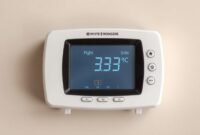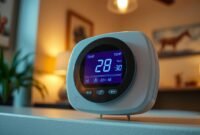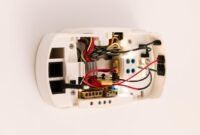Are you having trouble with your Honeywell thermostat? It can make your home uncomfortable and waste energy. Issues like unresponsive touchpads, blank screens, and error codes can be really frustrating.
This guide is here to help you fix common problems with your thermostat. Whether it’s about resetting or dealing with error codes, I’ve got you covered. You’ll learn how to solve these issues fast and save money.

Knowing how to handle these problems will make you more confident. You’ll be able to fix temperature issues and keep your home cozy again.
Understanding Your Honeywell Thermostat Model Types
Honeywell has a wide range of thermostats for different needs. They are the top brand for home comfort and energy saving.
Analog Thermostats: The Classic Control
Analog thermostats are the old-school way to control temperature. They have:
- Manual adjustment knobs or levers
- Simple mechanical design
- Direct temperature setting without digital interfaces
Programmable Digital Thermostats: Smart Scheduling
Digital thermostats offer more advanced features. They have:
- LCD display screens
- Programmable temperature schedules
- Multiple setting options
Smart WiFi-Enabled Models: Advanced Connectivity
Smart thermostats are the latest in home temperature control. They offer:
- Remote smartphone app control
- Learning capabilities
- Energy usage tracking
| Thermostat Type | Key Features | Best For |
|---|---|---|
| Analog Thermostats | Manual adjustment | Budget-conscious homeowners |
| Digital Thermostats | Programmable schedules | Users wanting basic automation |
| Smart WiFi Thermostats | Remote access, learning algorithms | Tech-savvy homeowners |
Knowing about these thermostat types helps you pick the best one for your home. It also helps you find the right way to fix any issues.
Power-Related Issues and Solutions
Dealing with thermostat power issues can be frustrating. But, most problems are simple to fix. Knowing the signs of power-related challenges is key to keeping your Honeywell thermostat working well.
Battery-operated thermostats need regular care. I suggest checking and replacing batteries every year or when the low battery light shows. Common signs of battery trouble include:
- Dim or blank display
- Inconsistent temperature readings
- Sudden system shutdowns
For hardwired models, circuit breaker issues can cut off power. Here’s a quick guide to check:
- Make sure the circuit breaker is on
- Look for tripped switches in your electrical panel
- Check wiring connections for damage
| Power Issue | Potential Solution | Recommended Action |
|---|---|---|
| Blank Display | Battery Failure | Replace Batteries |
| Intermittent Power | Loose Wiring | Secure Electrical Connections |
| No Power | Circuit Breaker Trip | Reset Circuit Breaker |
When facing thermostat power issues, a simple power cycle can help. Unplug the thermostat, wait 30 seconds, then plug it back in. If problems keep happening, it’s best to call a professional HVAC technician.
Honeywell Thermostat Troubleshooting Steps
Dealing with thermostat problems can seem tough, but it’s doable with the right steps. Knowing how to read error codes and perform diagnostic tests helps keep your home comfy and energy-efficient.

Basic System Checks
First, do these simple checks on your HVAC system:
- Make sure the thermostat mode is set right (heat/cool)
- Check if the temperature settings are correct
- Clean or replace the air filters
- Check if the circuit breaker hasn’t tripped
- Make sure the batteries are good
Read also: Why Hot Water Heater Keeps Tripping Breaker
Advanced Diagnostic Procedures
If basic checks don’t fix the problem, try these more detailed steps:
- Look at the thermostat wiring connections
- Adjust the thermostat’s temperature readings
- Check if the system is compatible
- Check the voltage (it should be 20-30VAC)
Error Code Interpretation
Honeywell thermostats show error codes for system problems. Knowing these codes helps find issues fast:
| Error Code | Potential Issue | Recommended Action |
|---|---|---|
| 164 | Heat Pump Problem | Check heat pump connections |
| 168 | Wi-Fi Connection Issue | Reset network settings |
| 170 | Internal Sensor Malfunction | Contact HVAC professional |
If these steps don’t work, call a pro HVAC technician. About 1 in 5 cases need expert help, like for complex dual-fuel systems.
For more help, call ABC Electrical & HVAC Service at (888) 868-6667 or HVAC support at 1-855-733-5465.
Display Screen Problems and Fixes
Thermostat display issues can be frustrating for homeowners. If you see a blank screen or an unresponsive touchpad, don’t worry. I’ll show you how to fix common display problems.
- Completely blank screen
- Unresponsive touchpad
- Dim or flickering display
- Error codes appearing randomly
For a blank screen, start with these basic checks:
- Verify battery status – dead batteries are often the culprit
- Check circuit breaker for possible power issues
- Inspect wire connections behind the thermostat
When facing an unresponsive touchpad, try these fixes:
- Gently clean the screen with a soft, dry microfiber cloth
- Perform a soft reset by removing and replacing the thermostat from its mounting
- Update firmware for smart WiFi-enabled models
| Display Issue | Potential Cause | Recommended Action |
|---|---|---|
| Blank Screen | Dead Batteries | Replace batteries immediately |
| Unresponsive Touchpad | Dirt/Moisture | Clean screen carefully |
| Flickering Display | Loose Wiring | Check electrical connections |
If basic troubleshooting doesn’t fix your thermostat display issues, it’s time to call a pro. A professional HVAC technician can find and fix more complex problems.
Temperature Reading Inconsistencies
Running into temperature issues with your Honeywell thermostat can be really annoying. Getting the right temperature is key for comfort and saving energy. Let’s explore how to fix these common problems.

Calibration Methods for Precise Readings
Calibrating your thermostat is vital for precise temperature control. Issues like wrong sensor placement or electronic interference can cause problems. Here are some steps to follow:
- Use a separate digital thermometer to compare readings
- Perform a manual calibration through the thermostat settings
- Check for possible electrical interference from nearby devices
Identifying Sensor Issues
Temperature sensors can wear out, leading to bad readings. Look out for these signs:
- Frequent HVAC system cycling
- Unresponsive temperature adjustments
- Inconsistent room temperatures
Read also: How to Adjust Temperature on Hot Water Heater
Optimal Thermostat Placement Considerations
Where you place your thermostat affects its accuracy. The right spot helps avoid false readings and keeps your home comfy. Here are some tips:
- Mount on interior walls away from direct sunlight
- Avoid proximity to heat sources or drafty areas
- Install approximately 5 feet from the floor
- Keep away from windows, doors, and air vents
By learning these calibration tips and sensor tips, you can better control your home’s temperature and save energy.
Wiring and Connection Problems
Dealing with thermostat wiring issues can be challenging. Loose connections often cause most HVAC system problems. It’s important to know how to handle your thermostat’s wiring for the best performance.
Here are the steps to diagnose thermostat wiring issues:
- Inspect wire connections for corrosion or damage
- Make sure each wire is correctly connected to its terminal
- Check that jumper settings match your HVAC system type
- Use a multimeter to check electrical continuity
Different HVAC systems need specific wiring setups. Electric furnaces use “HE” jumper settings, while gas furnaces use “HG” settings. Wrong connections can cause system failure or malfunction.
Signs of wiring problems include:
- Intermittent heating or cooling
- Display screen flickering
- Unexpected system shutdowns
- Unusual thermostat behavior
If you’re unsure about your thermostat’s wiring, it’s best to get help from a professional HVAC technician. Wrong wiring can damage your thermostat and heating/cooling system, costing a lot of money.
Smart Features and WiFi Connectivity Issues
Fixing smart thermostat problems can be tough, mainly with Wi-Fi issues. Honeywell smart thermostats need a steady internet to work well. This lets you control them from anywhere and integrate with apps smoothly.
Network Troubleshooting Strategies
Here are some steps to solve Wi-Fi problems:
- Check your network’s strength near the thermostat
- Make sure you’re using a 2.4 GHz network (Honeywell devices don’t work with 5 GHz)
- Ensure your router is close to the thermostat
- Try restarting your WiFi router by unplugging it for 5 seconds
Read also: White Rodgers Thermostat Troubleshooting
App Integration Solutions
Setting up app integration needs careful steps. Here are some tips to fix connection issues:
- Make sure you have the latest Honeywell Home app version
- Check that app permissions are set to “always on”
- Restart your mobile device before trying to connect again
- Turn off VPNs or GPS spoofers that might block the connection
Remote Access Troubleshooting
For ongoing remote access issues, try these expert tips:
- Check if you have internet on your main network
- Make sure the thermostat is registered for remote access
- Unplug the thermostat for 30 seconds to reset its network settings
- Call Honeywell Support at 1-800-633-3991 for more help
If you’re stuck after these steps, a WiFi range extender might help. It can boost your signal and make your smart thermostat work better.
Conclusion
Keeping your Honeywell thermostat in good shape is key for comfort and saving energy. I’ve found that regular checks can stop many problems before they start. Simple tasks like battery swaps and keeping it clean can make your device last longer.
While you can fix some issues on your own, others need a pro. Issues with wiring, constant problems, or complex system issues are best left to experts. It’s smart to do some maintenance yourself but call a pro when you need help, like with advanced models.
Being proactive is the best approach. Regular checks, air filter swaps, and knowing your thermostat model can save you money and time. Stay informed and watchful to keep your home comfy and energy-smart.


